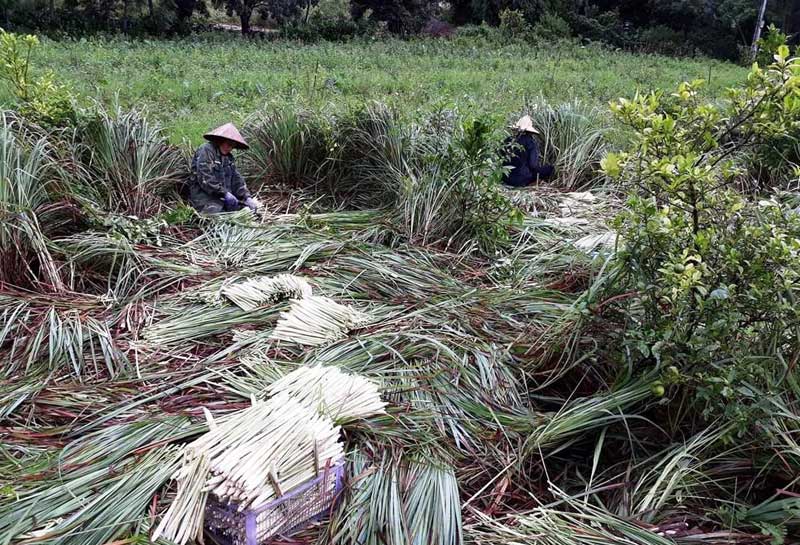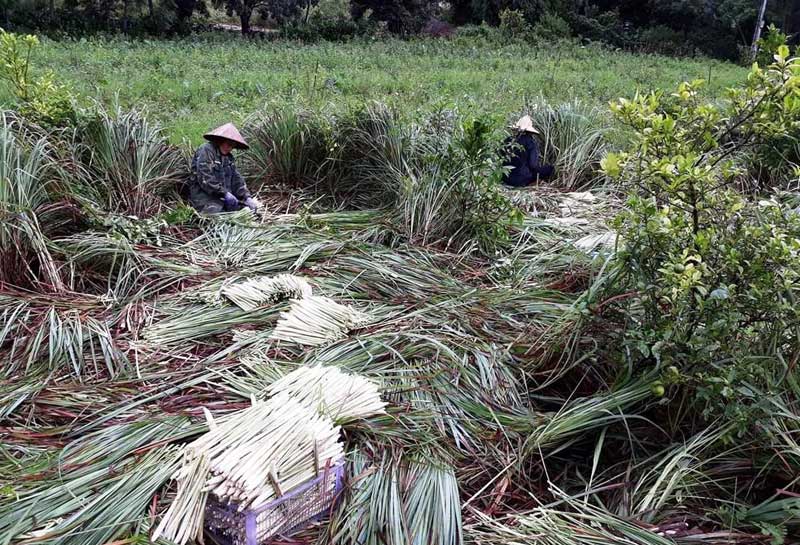
(HBO) - Hung Thi is one of the six difficult communes of Lac Thuy district, 90% of its population are Muong ethnic minority people. Their lives are still very difficult, and the economy is mainly dependent on forestation and livestock. Recognizing the economic benefits of lemongrass and its stable market consumption, the Committee and authorities of Hung Thi commune propagated and mobilized the local people to put lemongrass plants into growing on the land area of riverbank and hills. This makes the life of the farmers become quite well.

Lemongrass brings the income to the local
people of Tram village, Hung Thi commune
Talking to Mr. Pham Van Toan, the Head of
Tram village, we learn that: Up to now, the whole commune of Hung Thi has over
100 hectares of planting short hybrid lemongrass. This kind of plant is easy to
grow, easy to care, with nearly no disease; it can give high yield with the
time from planting to harvest of only 4.5 - 5 months. Two months later, another
crop can be collected. The harvesting period of lemongrass to be replanted is
after 3 years. On average, 1 hectare of lemongrass will be harvested for 5-7
crops, after deducting all the expenses, the farmers can earn the profit from
100-140 million VND / hectare.
For the people of Tram village, the village
9, the hamlet 8 and Mang village, at present, some house have about from some
perches to 1 hectare planting lemongrass, some other houses have up to 5 - 7
hectares. All products were collected by Mr. Pham Van Toan, the Head of Tram
village with prices ranging from 6,000 to 6,500 VND / kg, then they will be
sold to major wholesale markets in Hanoi and Vinh Phuc. According to Toan's
share, on average, he buys more than 2 tons of lemongrass roots every day. For
the months prior to Tet holiday, there are some days he collected dozens of
tons of lemongrass, but that amount didn’t meet the need of the market. In
addition to growing lemongrass in river banks, replacing the field bottom
planting vegetables before, lemongrass is also planted at the edge of the roads
or hill areas; it can be planted scattered in the fruit trees to help limit
weeds and increase the income for the local people.
Since the beginning of this year, under the direction of the Department of Agriculture and Environment, the Sub-Department of Agricultural, Forestry, and Fishery Product Quality Management has strengthened the integration of the professional activities to promote and guide the organizations and individuals in the production and trading of agricultural, forestry, and fishery products to comply with the legal regulations regarding the use of chemicals, pesticides and veterinary medicines in crop cultivation, livestock farming and aquaculture. They also provide guidance to processing and manufacturing establishments on keeping the records to trace the product origins and using food additives from the approved list according to the regulations.
Hoa Binh province saw a significant rise in state budget revenue in the first two months of 2025, heard a meeting chaired by Vice Chairman of the provincial People’s Committee Quach Tat Liem.
Ha Thi Ha Chi, a 26-year-old graduate in law, has taken an unconventional path by returning to her hometown in Mai Chau district to establish the Tong Dau Cooperative, creating stable jobs for local women and bringing Thai ethnic brocade weaving to the global market.
As the Lunar New Year 2025 approached, pork prices surged, creating a profitable season for farmers in Tan Vinh commune, Luong Son district. Taking advantage of the rising demand, Can Minh Son, a farmer from Coi hamlet, sold over 30 pigs at 69,000 VND/kg, each weighing more than 100 kg. After deducting expenses, his family earned a profit of over 50 million VND.
alternate member of the Central Party Committee, Secretary of the Hoa Binh provincial Party Committee Nguyen Phi Long on March 5 had a working session with Yan Jiehe, Founder and Chairman of the China Pacific Construction Group, one of China's largest private corporations in the field of transport infrastructure. Deputy Secretary of the provincial Party Committee, Chairman of the provincial People's Committee Bui Duc Hinh and leaders of provincial departments and sectors also attended the working session.
The electronic printed circuit board (PCB) manufacturing and processing plant of Japan’s Meiko Group, located at Da River Left Bank Industrial Park in Hoa Binh city with a total investment of over 200 million USD, is expected to create thousands of jobs and make a significant contribution to the local budget.



